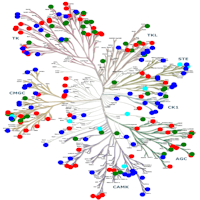Posttranslational Modifications

Modification of a protein with functional groups after the translation of the amino acid chain is a common mechanism of altering its behavior, for instance leading to activation or inactivation. Studying the creation and erasure of these posttranslational modifications (PTMs) in the whole proteome by mass spectrometry requires computational support on many levels.
We engage in PTM analysis in many ways including reliable identification of modified peptides, localization of the modified site(s) on these peptides, quantification of site activation profiles over multiple experimental conditions and time series, estimation of site occupancies, determination of sequence motifs around modified sites, interpretation of kinase substrate relations, investigation of structural properties and many more topics.
Selected publications:
Sharma, K., D’Souza, R.C.J., Tyanova, S., Wisniewski, J.R., Schaab, C., Cox, J. and Mann, M. (2014) Ultra-deep human phosphoproteome reveals distinct regulatory nature of Tyr and Ser/Thr-based signaling. Cell Reports.
Tyanova, S., Cox, J., Olsen, J., Mann, M. and Frishman, D. (2013) Phosphorylation variation during the cell cycle scales with structural propensities of proteins. PLoS Comput Biol 9:e1002842.
Marx, H., Lemeer, S., Schliep, J.E., Matheron, L., Mohammed, S., Cox, J., Mann, M., Heck, A. and Kuster, B. (2013) A large synthetic phosphopeptide library for mass spectrometry based proteomics. Nature Biotechnol 31, 557-564.
